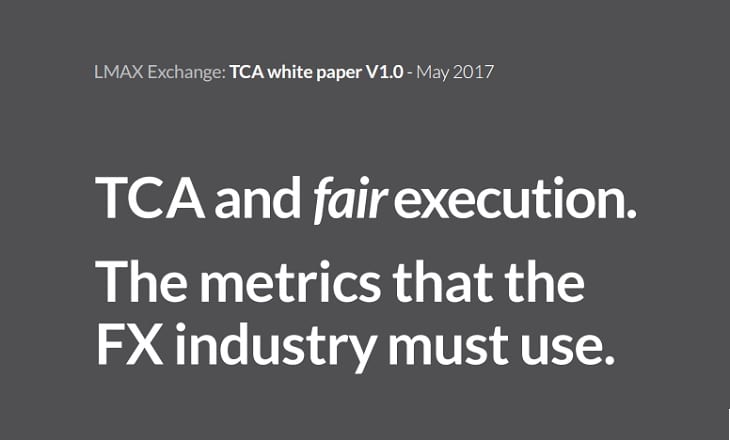LMAX Exchange, the FCA regulated MTF for global FX trading, has issued a white paper several months in the making. LMAX’s report is a scathing review regarding the way the institutional global FX market works today, and offers ways to fix things.

LMAX stated that the paper aims to begin a period of FX industry engagement, debate and agreement to better market structures that benefit all participants.
The analysis reveals significant differences in trading on firm vs. last look liquidity, and proposes a new combination of metrics to conduct Transaction Cost Analysis (TCA). The white paper is launched against a backdrop of increased pressure on institutions to report trading activity costs and ensure transparency in execution as part of both MiFID II regulation and as part of the upcoming FX Global Code of Conduct.
The white paper argues that existing TCA methods have been calibrated around last look liquidity and fail to take into account key advantages of trading on firm liquidity, including the ability to protect valuable trade information pre-execution; the potential to gain value from price improvement and avoid the cost of last look hold time; and the flexibility to optimise trading strategies by adjusting price discretion to control fill ratios.
The research was conducted by analysing data from an independent Third Party Aggregator (TPA), containing 7 million orders sent to seven LPs (both firm and last look) in 2016.
It found there are clear financial consequences to trading on different liquidity pools. Specifically:
- The cost of trading was higher on last look liquidity, by between $2.25-$48.86/million;
- Firm liquidity allows traders to gain value from price improvement, transparently passed on to them;
- Firm liquidity enables traders to avoid the cost of last look hold time, estimated at $25/million at 100ms for a rejected order, with 60% of costs incurred in the first 10ms.
By examining the underlying processes of both firm and last look liquidity, the white paper proposes a set of metrics to effectively compare the different liquidity pools, something it argues existing TCA methodologies fail to do.
Five key metrics are identified as important to achieve that comparison: fill ratio, price variation, hold time, market impact and bid-offer spread. The first three form the core of the publication, while market impact is also analysed. Key findings on the metrics include:
Fill ratio is not directly comparable between last look and firm liquidity, as different processes are measured;
- Price improvement is important and should be included in the base metrics set alongside slippage as combined price variation;
- Last look hold time, or discretionary latency, is an important hidden cost of trading that needs to be measured;
- Market impact is not usually measured, but is crucial to consider when interpreting execution quality.
As the FX Global Code of Conduct is finalised, this research points towards the need to complement that work with a TCA methodology that better reflects the differences between trading on last look and firm liquidity, and which in turn can help traders to make more informed choices on execution and liquidity.
There will be further research and publications from LMAX Exchange over the coming months that continue to interrogate further developments in this critical area for FX trading.

David Mercer, LMAX Exchange
David Mercer, CEO of LMAX Exchange, comments:
We hear a lot about the importance of transparency in FX trading, but at present there is too much complexity and confusion when it comes to assessing the true cost of trading. In essence, the current system is broken and fails to properly assess the true costs.
Traders are being asked to navigate a maze of differing standards and benchmarks. They need clarity and it is our responsibility as an industry to provide it. This research seeks to help meet that need: offering the foundations for what we hope will become a commonly agreed methodology for conducting Transaction Cost Analysis.
To be effective, TCA must recognise and reflect the clear differences between trading on last look and firm liquidity. The metrics commonly applied at present do a disservice to the quantifiable advantages of trading on firm liquidity, which need to be better understood as last look increasingly comes into question as a market practice.
Ultimately, better TCA should be about helping the industry move towards a position where traders are in control of their trading costs and can set their liquidity strategy accordingly, which benefits true market makers in turn. While there may be disagreements within the industry over the veracity of specific trading practices, we should all be able to agree that traders need better tools to understand the true cost of trading and value of liquidity.
Our intention with this white paper is to contribute to an industry-wide debate on how to conduct TCA in a way that benefits the customer, provides a fair comparison for liquidity providers, and creates genuine transparency: one that enables choice and aids quality decision making.
We are conscious of the “well they would say that” observation, irrespective of the lengths we have gone to internally to conduct an unbiased and fair assessment.
We believe in market structure, so this research should be understood as an invitation to all market participants to engage with us, test the validity of our findings and work together in developing the next generation of FX TCA methodology for the ultimate benefit of the wider market.
The LMAX Exchange white paper is available to download here (pdf).
